Wordfence and Sucuri are two of the best and most popular WordPress security plugins on the market. They are both highly recommended and incredibly helpful in keeping your WordPress site secure. This makes it hard for beginners to choose which one is right for them.
We used the Sucuri plugin for many years on WPBeginner, so we are very familiar with all its features. Then, we thoroughly tested Wordfence to see how it compares and paid special attention to the pros and cons for WordPress users.
In this article, we will compare Wordfence and Sucuri and share our expert opinion on which one is better for overall WordPress security.
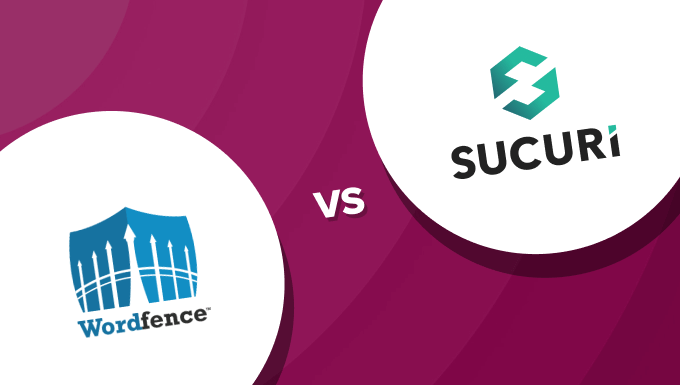
Comparing Wordfence vs Sucuri – What to Look For
Wordfence and Sucuri are two of the top WordPress security plugins. They offer comprehensive protection against brute-force attacks, malware infections, and data theft.
As a website owner, you will need to choose a security plugin that not only protects your WordPress website but does it efficiently.
You will also want something that requires less maintenance so you can focus on growing your business.
One of the most important steps in securing your WordPress site is to use a WordPress security plugin. These are plugins that help you harden WordPress security while blocking brute force attacks on your website.
Syed Balkhi
Lastly, you need to pick a security plugin that is easy to use and does not require technical skills to set up / maintain.
For this guide, we will compare Sucuri vs Wordfence side by side. Our comparison is divided into the following categories:
- Ease of Use – Managing website security can be quite technical. We will see how our contenders make it easier for users.
- Website Application Firewall (WAF) – A website firewall blocks malicious activity before it can interact with your WordPress website. We will compare how efficiently these plugins handle this.
- Security Monitoring and Notifications – How our contenders monitor website security and alert users about potential vulnerabilities.
- Malware Scanner – We will compare both plugins in terms of their ability to scan, identify, and alert users about malware.
- Hacked Website Clean-up – How these plugins help you clean up a hacked WordPress site.
Keep in mind that we used to use Sucuri on WPBeginner, so we are already very familiar with all its features. Plus, we have extensively tested Wordfence over the years to see how it stacks up as a free solution.
Here is a quick list of the topics we will cover, and you can use the quick links to jump to the section you want to read:
Ease of Use
Website security is a highly complex and technical field. That’s why our first comparison category is ease of use.
Let’s see how easy it is to use Wordfence vs. Sucuri to protect your website.
Wordfence – Ease of Use
Setting up Wordfence is quite easy. Immediately after installing the plugin, just click on the ‘Get your Wordfence license’ button.
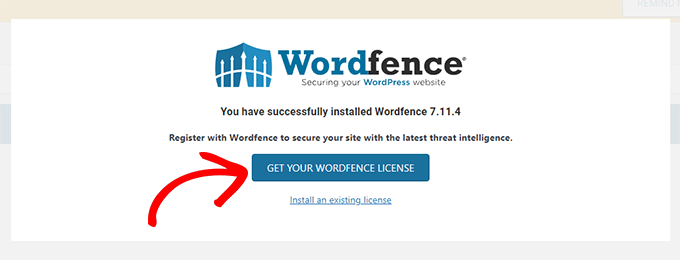
This will take you to the Wordfence website, where you can choose a license plan (Wordfence offers a free plan).
After choosing the plan, you will be asked to provide an email address.
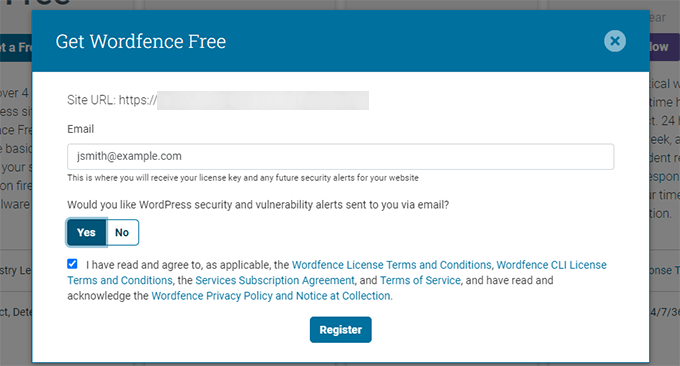
Fill in your email address, check the terms and conditions checkbox, and then click ‘Register’.
You’ll then receive your plugin license via email. You need to copy the license key from the email message and switch back to your WordPress website.
Now, click on the ‘Install an existing license’ button.
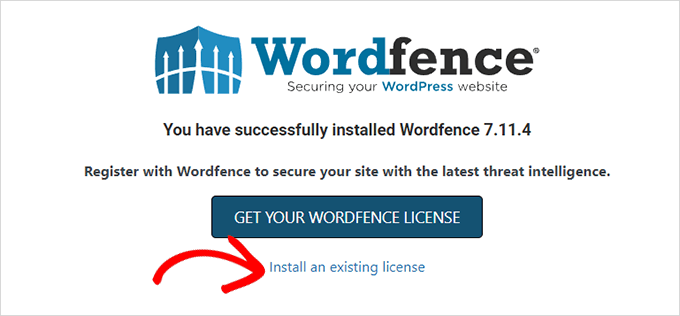
Next, you need to enter the email address you used to register for the license key.
Below that, enter the license key you received via email.
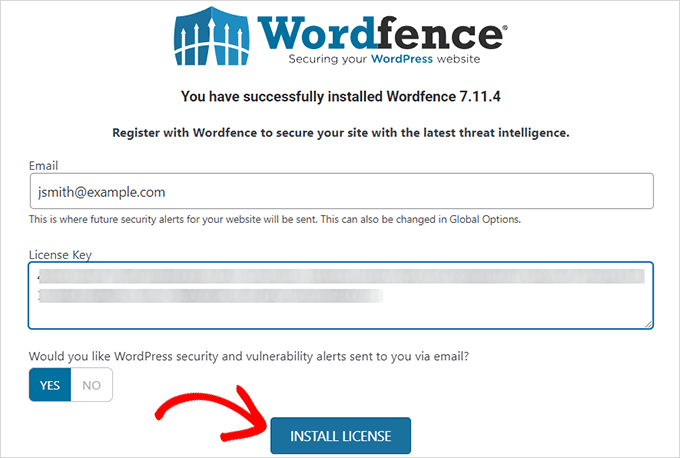
You will be asked to opt-in to receive WordPress security and vulnerability alerts. These alerts are not related to your website but general WordPress security-related events.
Simply click on the ‘Install License’ button to store your settings.
This will bring you to the Wordfence dashboard.
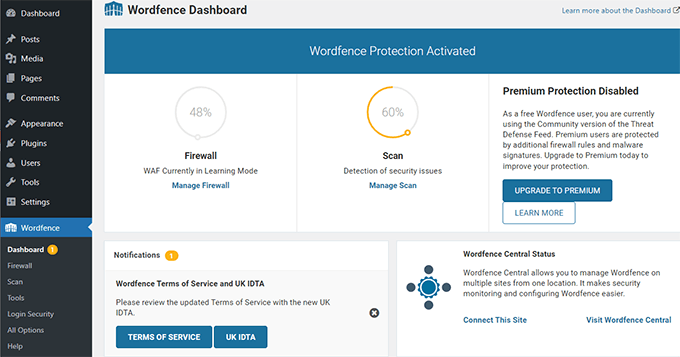
The plugin will turn on the website application firewall in the learning mode and run an automatic scan in the background.
Depending on the size of your website, any issues will be listed in the ‘Results Found’ tab.
Clicking on a Result will expand to show its details and the recommended actions you need to take.
For example, here, it showed that a new version is available for one of the installed plugins.
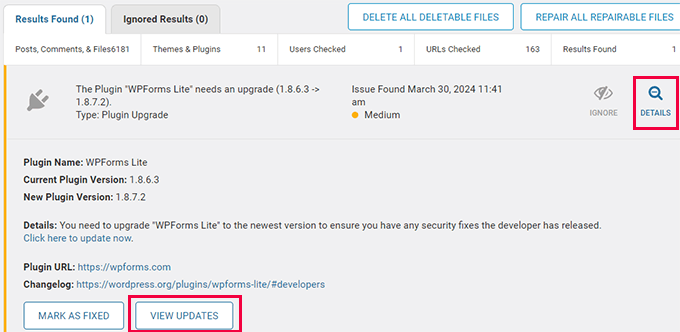
Wordfence also comes with a website firewall, which runs as a WordPress plugin on your website server, making it less effective.
Wordfence allows you to run it in the extended mode for better protection, but you’ll have to set it up manually (more on this later).
The basic Wordfence plugin setup is simple and does not require too much user input. However, the user interface is a bit cluttered, which may make it difficult for beginners to find certain settings/options.
Sucuri – Ease of Use
Sucuri offers a cleaner user interface with no unnecessary prompts popping up on the screen. It also runs a quick security scan upon activation, and you will see notifications in the plugin’s dashboard.
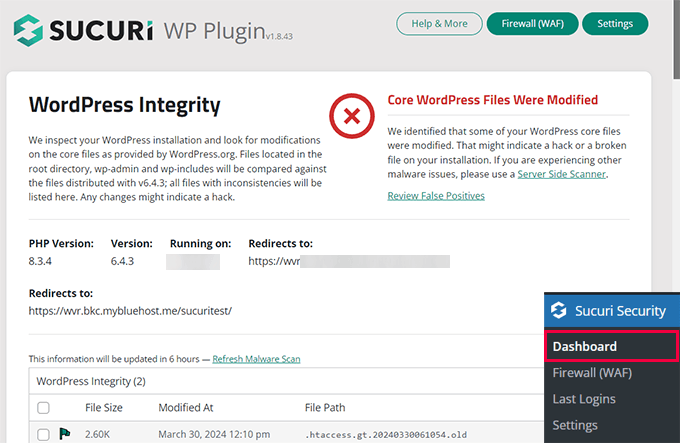
Sucuri’s free WordPress plugin only includes a scanner and does not come with a website firewall.
It offers a paid upgrade to unlock the firewall. Pricing for the paid upgrade starts at $199.99 per year.
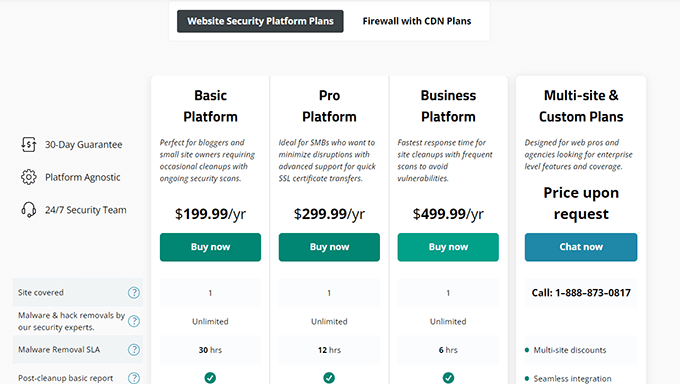
However, regarding effectiveness and performance, Sucuri’s website application firewall (WAF) is much better.
It is a cloud-based firewall, which means it does not run on your hosting server. In other words, no technical maintenance is required on your end.
You will need to add your API key and configure DNS settings for your domain name. This will allow the firewall to catch malicious traffic before reaching your WordPress hosting server.
Once set up, you will not need to worry about updating or maintaining it in the future.
Sucuri also makes it easy to use recommended security hardening settings on your website. All you need to do is click to apply these settings.
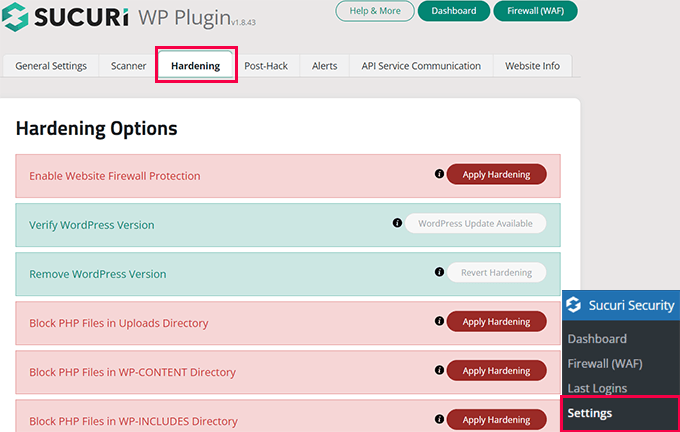
The overall user interface is nice. However, users will still need to dig deeper to find the options that they are looking for.
Updating nameservers on the domain registrar is an additional step required to set up Sucuri’s firewall, and it can be a bit difficult for some non-techy users.
The good thing is that the most popular domain registrars, like Domain.com, GoDaddy, etc, will be able to help you set it up.
Winner: Sucuri
Website Application Firewall (WAF)
A WordPress website firewall monitors incoming traffic to your site and blocks common security threats.
There are different ways to implement a firewall (application-based vs. cloud-based). In our experience, cloud-based firewalls are more efficient and reliable in the long run.
Both Sucuri and Wordfence offer website application firewalls. Let’s see how they differ.
Wordfence Website Application Firewall
Wordfence offers a website application firewall that monitors and blocks malicious website traffic. This is an application-level firewall, meaning it uses your server resources to run.
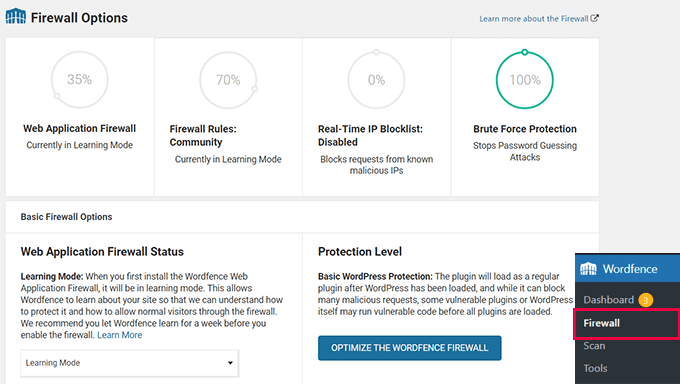
By default, Wordfence turns it on with the basic mode.
This means the firewall runs as a WordPress plugin, so WordPress has to load before an attack can be blocked.
This can take up a lot of server resources, and it’s not efficient.
To change that, you will need to manually set up the Wordfence firewall in extended mode.
Just go to the Wordfence » Firewall page and click on the ‘Manage Firewall’ button.
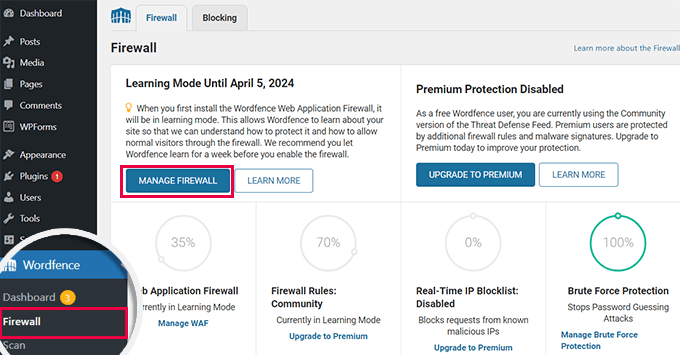
This will bring you to the Firewall Options page.
From here, go ahead and click the ‘Optimize the Wordfence Firewall’ button.
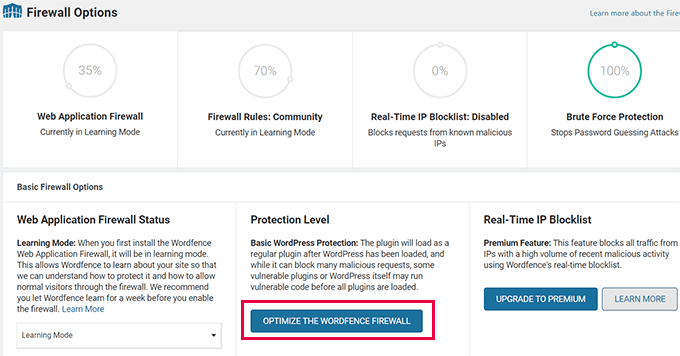
Next, you need to choose a configuration level for your firewall based on which web server software your hosting company is using.
For instance, if your web host is using Apache, then you can choose one of the Apache options. You can always ask your hosting provider about which server software they are using.
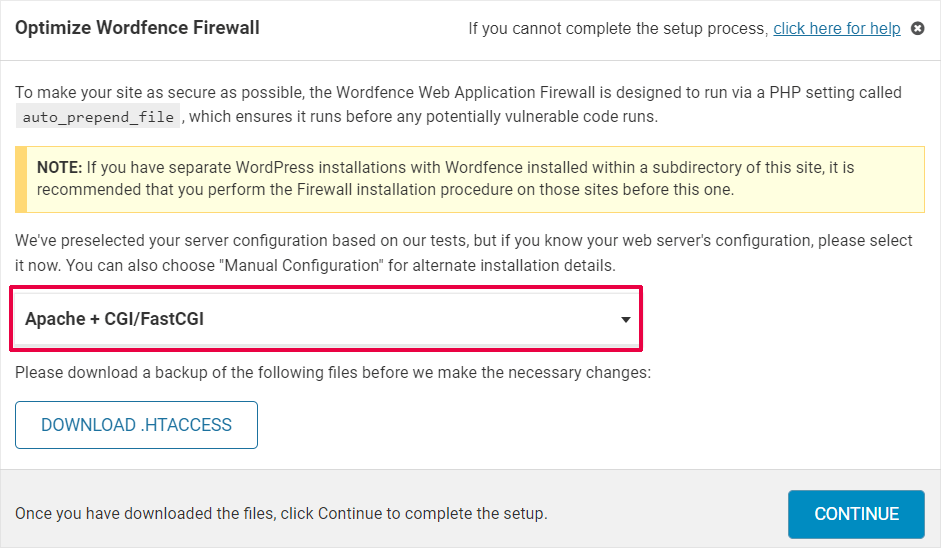
After that, click on the ‘Download .htaccess’ button and click ‘Continue’.
Wordfence will apply settings and will show you a success message.

This will allow the firewall to monitor traffic before it reaches your WordPress installation.
However, it is still an endpoint firewall. Wordfence can only block traffic once it has reached your hosting server.
In case of a DDOS attack or brute force attempt, your server resources will still be affected, and your website performance will be down. It may even crash.
When you first activate Wordfence, their firewall is in learning mode. It learns how you and other users access your WordPress website. During this time, several firewall rules are not applied to ensure that legitimate website users are not accidentally blocked.
Sucuri Website Application Firewall
Sucuri offers a cloud-based website application firewall, which blocks suspicious traffic even before it reaches your hosting server.
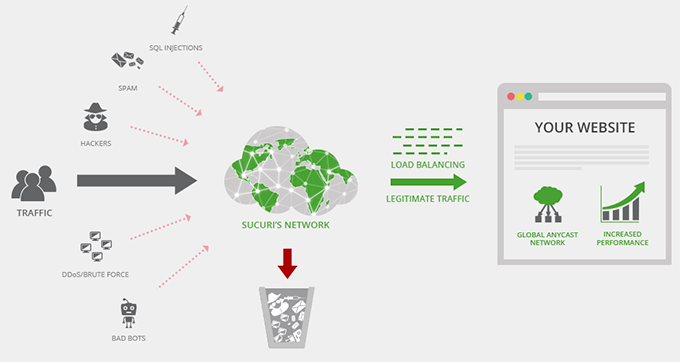
This saves you a lot of server resources and instantly improves your website speed.
Sucuri’s CDN servers are located in different regions, which is another bonus for website speed.
To use the firewall, you must change the DNS settings of your domain name. This change will allow all your website traffic to go through Sucuri’s servers.
There is no basic or extended mode. Once setup is complete, Sucuri’s WAF will protect your website from malicious requests, DDOS attacks, and limit login attempts.
It also has a robust machine-learning algorithm that is sophisticated enough to prevent false positives.
Sucuri lets you go from high-security mode to paranoid mode when you experience DDoS. This ensures that your website server doesn’t crash.
Winner: Sucuri
Security Monitoring and Notifications
As a website owner, you need to know as soon as possible if something is wrong on your website. A security issue can cost you customers and money.
To receive these notifications, you need to make sure that your WordPress site can send emails. The best way to ensure that is by using an SMTP service to send WordPress emails.
Let’s see how Wordfence and Sucuri handle website monitoring and alerts.
Wordfence Monitoring and Alerts
Wordfence has an excellent notification and alert system.
First, notifications will be highlighted next to the Wordfence menu in the WordPress admin sidebar and dashboard.
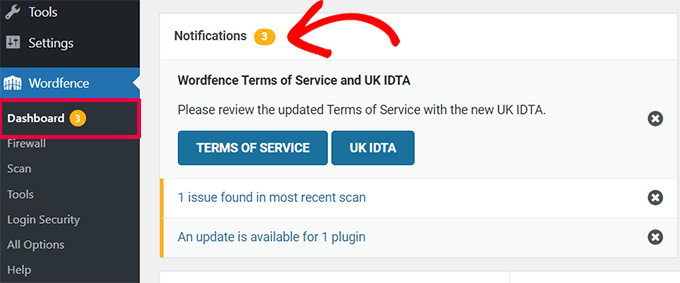
They are highlighted according to their severity. You can click on a notification to learn more about it and how to fix it.
However, you will see this only when you log in to the WordPress dashboard.
Wordfence also comes with instant notifications via email. To configure email alerts, just go to the Wordfence » All Options page and scroll down to the ‘Email Alert Preferences’ section.
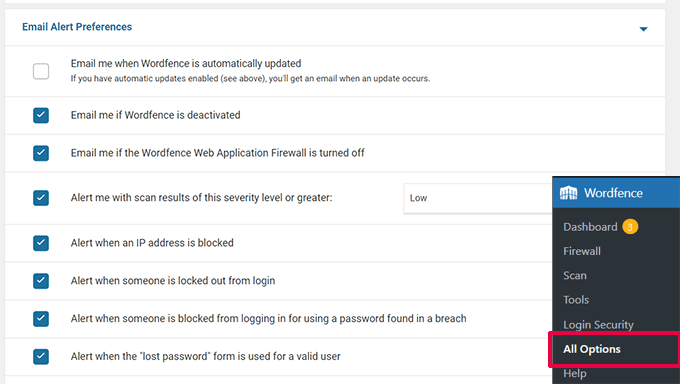
From here, you can turn email alerts on/off. You can also choose the severity level to send an email alert.
Sucuri Monitoring and Alerts
Sucuri also displays critical notifications on your dashboard. The top right corner of the screen is dedicated to displaying the status of core WordPress files.
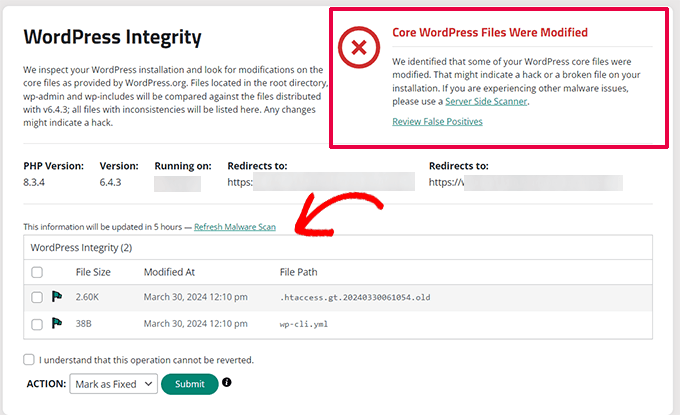
Below that, you’ll see the audit logs and site health status.
Sucuri comes with a complete alert management system. Simply visit the Sucuri Security » Settings page and switch to the ‘Alerts’ tab.
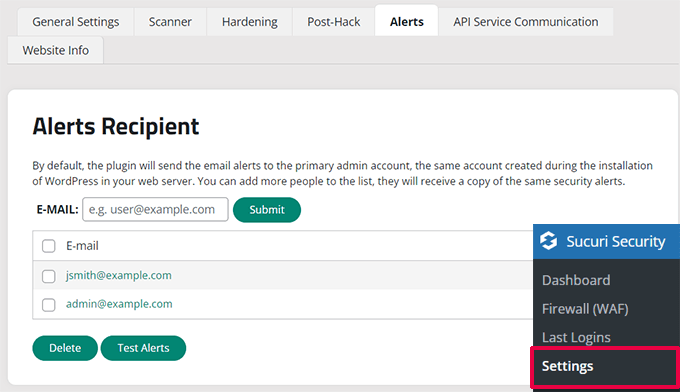
You can add email addresses where you want to be notified.
After that, you can customize email alerts further.
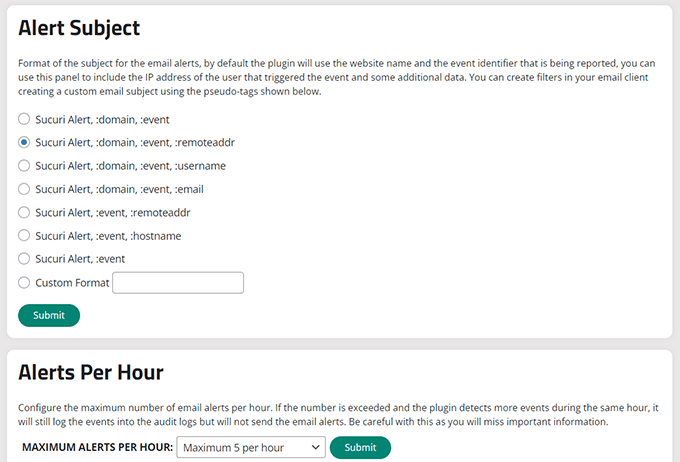
You can choose events you want to be notified about and the number of alerts per hour, as well as customize settings for brute force attacks, post types, and alert email subjects.
Their website application firewall will also send automated high-level alerts to your email.
Winner: Tie
Malware Scanner
Both plugins have built-in security scanners to check your WordPress site for malware, changed files, and malicious code.
Let’s see how Wordfence and Sucuri scan for malware and other issues.
Wordfence Malware Scanner
Wordfence comes with a powerful scanner that is highly customizable to meet your hosting environment and security concerns.
By default, the scan is enabled with limited scan settings (to save server resources on shared hosting plans).
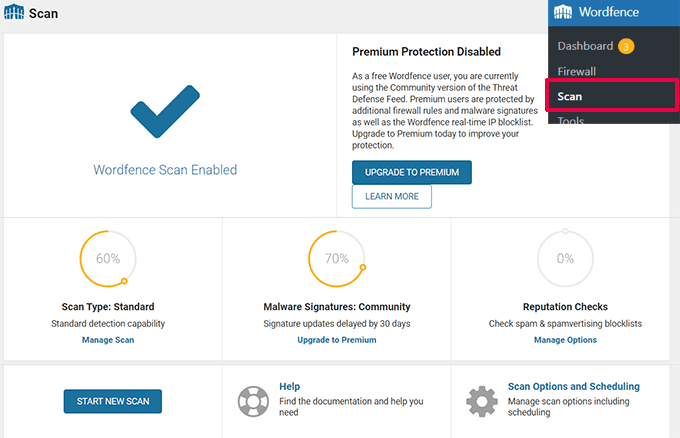
For the free version, Wordfence automatically decides a scan schedule for your site. Premium version users can choose their own scan schedule.
You can set up the scanner to run in different modes. Some scan options are only available with the premium version.
The Wordfence scanner can also check your plugin and themes to ensure they match the repository version.
Sucuri Malware Scanner
The Sucuri malware scanner uses Sucuri’s Sitecheck API. This API automatically checks your site against multiple safe-browsing APIs to ensure that your website is not blacklisted.
It automatically checks the integrity of your core WordPress files to make sure that they are not modified.
You can customize the scan settings in the ‘Scanner’ tab on the Sucuri Security » Settings page.
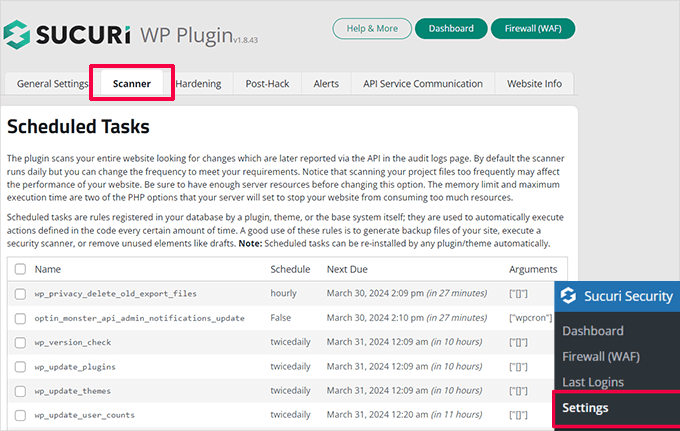
Sucuri’s free scanner runs on the publicly available files on your website. It is not a WordPress-specific scanner, so it is incredibly good at detecting any type of malware and malicious code.
It is also less intrusive on your server resources, which is an added bonus.
Winner: Sucuri
Hacked Website Clean-Up
Cleaning up a hacked WordPress site is not easy. Malware can affect several files, inject links in your content, or block you out of your own website.
Manually cleaning everything by yourself is not possible for most beginners.
Wordfence and Sucuri offer site clean-up and malware removal services. Let’s take a look at which one does it better.
Wordfence Site Clean-Up
Wordfence site cleanup service is not included in their free or premium plans.
It is sold with Wordfence Care (Pricing: $490 per year) and Wordfence Response plan (Pricing: $950 per year).
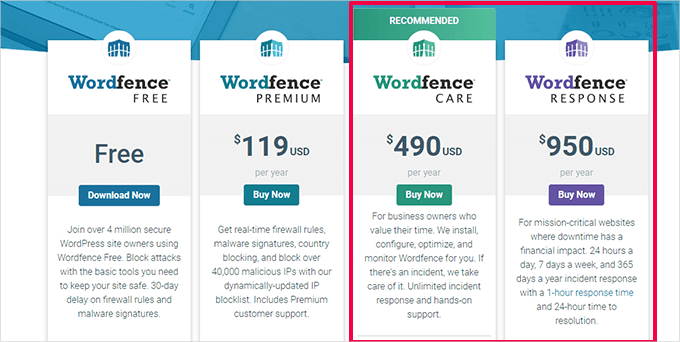
Site clean-up will also give you a premium Wordfence license for one website.
The malware cleanup process is pretty straightforward. They will scan your site for malware/infections and then clean up all affected files.
Their team will also investigate how hackers gained access to your site and prepare a detailed report on the entire clean-up process with suggestions for future prevention.
Sucuri Site Clean-Up
All paid Sucuri plans include a website clean-up service. This comes with site cleanup, blacklist removal, SEO spam repair, and WAF protection for future prevention.
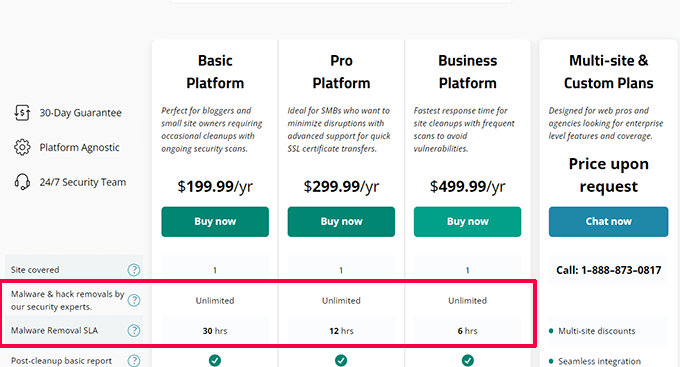
Keep in mind that you are also getting a cloud-based firewall with these plans.
They are good at cleaning up malware, removing any injected spam code, and backdoor access files.
The process is quite straightforward. You open a support ticket, and their team will start working on the cleanup process.
They will use your login credentials for FTP/SSH access or cPanel. During the process, they log every file they touch and automatically back up everything.
Winner: Sucuri – All premium plans include malware removal, and you also get a cloud-based firewall.
Final Verdict: Wordfence vs. Security – Which One Is Better?
In our opinion, Sucuri is a better overall WordPress security plugin. However, Wordfence is not that far behind.
Here are the advantages of using Sucuri over Wordfence:
- It offers a cloud-based website firewall, which protects your website more efficiently, reduces the server load, and improves WordPress speed and performance.
- Even their starter paid plan includes a malware removal service.
For users who can afford to spend on a paid plan, our recommendation is Sucuri.
Related: Take a more in-depth look at our detailed Sucuri review, which includes more pros and cons.
For users who are just getting started and can’t afford a security plugin, we recommend using Wordfence.
It offers a great free WordPress security plugin with a malware scanner.
It can be used as a security monitoring and scanning plugin alongside the Cloudflare free CDN to have a cloud-based basic firewall.
At WPBeginner, we use the enterprise plan of Cloudflare DNS.
However, even the free Cloudflare DNS is excellent at preventing the most common WordPress attacks while boosting your website speed and performance. See our comparison of Sucuri vs. Cloudflare.
Editor’s note: We have used Sucuri on the WPBeginner website to boost our security.
Bonus: Professional Hacked Site Cleanup
Cleaning up a hacked website is not easy. Wouldn’t it be great if someone else did it for you?
The easiest way to restore a hacked WordPress website is by using the Hacked Website Repair service from WPBeginner.
Our team of WordPress security experts has more than 15 years of experience, our software powers more than 25 million websites, and ours is a name you can trust.

One of our WordPress security experts will clean up your WordPress files, install updates, and create a backup of your cleaned site. Plus, we offer a priority service that can clean up your website in just one business day, which is perfect for critical and high-traffic websites.
We hope this article helped you compare Wordfence vs. Sucuri and determine which is better for your needs. You may also want to follow our complete WordPress security guide for step-by-step instructions on how to protect your website or see our eCommerce security tips to secure your WordPress store.

 Syed Balkhi
Syed Balkhi



Jiří Vaněk
Which of these plugins is better when the site is already hacked? So mainly to scan data and search for possible backdoors? Since WordPress attacks are quite common these days, I am looking for a quality scanner that will be able to perform a scan of an already attacked system and remove potential harmful data.
WPBeginner Support
For cleaning up a site we would recommend taking a look at Sucuri’s service to help clean up a site.
Admin
Jiří Vaněk
Thank you for answer. Sometimes I come across a site whose owner has been hacked and that’s why I’ve been looking for a quality troubleshooting tool. I have a THOR and Maldetect system on my linux server for this, but I was looking for such a ready-made solution on other shared websites. Thank you. I will install the plugin on my test site and learn how to work with it.
Aditya
First of all thanks for great content. I have one problem when i install sucuri. It shows (Core WordPress Files Were Modified) after scanning.
Are these files are secure. And if it is how to remove (We identified that some of your WordPress core files were modified) these notification.
WPBeginner Support
You would need to check the files for if there have been changes. In the plugin’s settings for the scanner, you would be able to let the plugin know about false positives. For how to use a plugin we would recommend checking out the support for the plugin for the most up to date information.
Admin
Clare Ferdinands
thank you for the comparison. its exactly what i needed to decide which one the use.
WPBeginner Support
You’re welcome, glad our guide could be helpful
Admin
Christopher Eller
Can you clarify this conclusion?
“Conclusion – Both Wordfence and Sucuri are excellent WordPress security plugins. However, we believe that Sucuri is the best WordPress security plugin overall.”
Is the FREE version of Sucuri included in that statement? Or is this conclusion ONLY true if we use the paid version of Sucuri?
Thank you,
Chris
Editorial Staff
Hey Chris,
This is specifically for the premium version of the plugin
Admin
Leo
What about installing of both? Wordfencen andf Sucuri. Are they complemental? I’ve had them both working without any problems.
WPBeginner Support
We would only recommend one to prevent the possibility of them conflicting with each other.
Admin